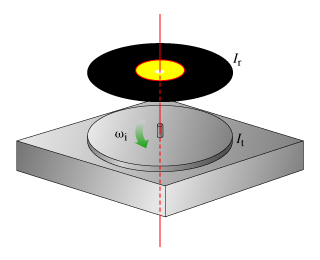Consider a turntable to be a circular disk of the moment of inertia I_t rotating at a constant angular velocity ωi(note that angular velocities use the Greek letter omega and not double-u) around an axis through the center and perpendicular to the plane of the disk (the disk's "primary axis of symmetry") as shown in(Figure 1). The axis of the disk is vertical and the disk is supported by frictionless bearings. The motor of the turntable is off, so there is no external torque being applied to the axis.
Another disk (a record) is dropped onto the first such that it lands coaxially (the axes coincide). The moment of inertia of the record is Ir. The initial angular velocity of the second disk is zero.
There is friction between the two disks.
After this "rotational collision," the disks will eventually rotate with the same angular velocity.

Part A
What is the final angular velocity, ωf, of the two disks?
Express ωf (omega subscript f) in terms of It, Ir, and ωi (omega subscript i).
Part B
Because of friction, rotational kinetic energy is not conserved while the disks' surfaces slip over each other. What is the final rotational kinetic energy, Kf, of the two spinning disks?
Consider a turntable to be a circular disk of the moment of inertia I_t rotating at a constant angular velocity ωi(note that angular velocities use the Greek letter omega and not double-u) around an axis through the center and perpendicular to the plane of the disk (the disk's "primary axis of symmetry") as shown in(Figure 1). The axis of the disk is vertical and the disk is supported by frictionless bearings. The motor of the turntable is off, so there is no external torque being applied to the axis.
Another disk (a record) is dropped onto the first such that it lands coaxially (the axes coincide). The moment of inertia of the record is Ir. The initial angular velocity of the second disk is zero.
There is friction between the two disks.
After this "rotational collision," the disks will eventually rotate with the same angular velocity.

Part A
What is the final angular velocity, ωf, of the two disks?
Express ωf (omega subscript f) in terms of It, Ir, and ωi (omega subscript i).
Part B
Because of friction, rotational kinetic energy is not conserved while the disks' surfaces slip over each other. What is the final rotational kinetic energy, Kf, of the two spinning disks?
